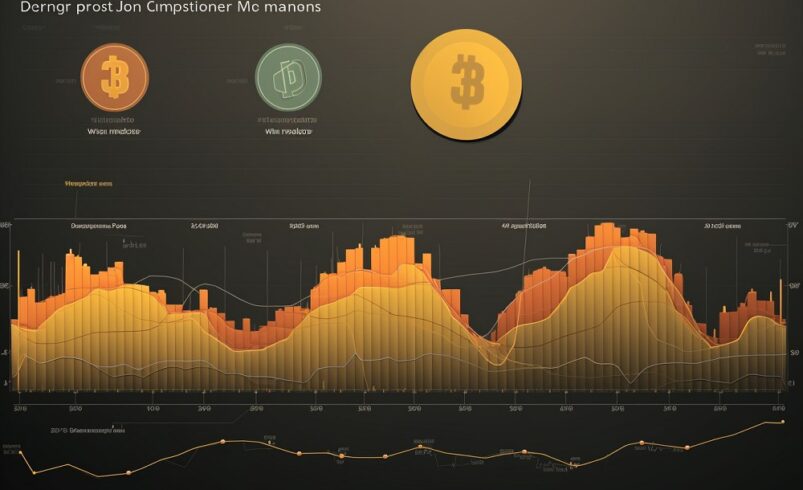Market Liquidity: A Guide To Inflationary and Deflationary Token Models:

Tokenomics is a fundamental aspect that shapes cryptocurrencies’ functionality and value dynamics. At its core, tokenomics revolves around the principles of supply and demand.
This guide explores the two models guiding tokenomics, the inflationary and deflationary token models, and their impacts on market liquidity.
Tokenomics Basics
The interplay of supply and demand in tokenomics dictates the circulation of tokens, the timing of token introduction or withdrawal from the market, and, ultimately, the value and utilization of such a token.
Inflationary Tokens
Inflationary tokens operate on the principle of ensuring a steady and accessible token supply within the market. The mechanisms employed by these tokens aim to encourage user participation by offering rewards through mining or staking activities.
Cryptocurrency inflation mirrors traditional economic principles, wherein the increasing supply of tokens over time gradually devalues each token. This decline in purchasing power is a fundamental aspect of inflationary tokens, where the supply increases consistently.
Token Issuance Mechanisms
Mining and staking are primary methods used by inflationary tokens to bolster their supply. Mining involves solving complex mathematical problems to validate transactions on a blockchain, earning tokens as a reward.
Conversely, staking requires users to hold and lock a certain amount of tokens in a wallet to support the network and receive additional tokens as rewards.
Impact On Market Dynamics
Inflationary tokens aim to maintain a balance between sufficient liquidity for daily transactions and incentivizing user engagement through rewards. However, this continuous influx of tokens into the market can impact the value of each token.
An illustrative example of an inflationary token is Dogecoin (DOGE), famously created as a fun alternative to other cryptocurrencies. DOGE’s creator eliminated its supply cap, ensuring an infinite supply of tokens.
Consequently, as its supply surpassed demand, the value of DOGE declined over time. Despite their potential devaluation, inflationary tokens often attract users due to their accessibility and ability to support regular payment settlements.
The ease of obtaining these tokens through activities like mining or staking encourages broader community involvement, contributing to the network’s growth.
Deflationary Tokens
Deflationary tokens are engineered to reduce or maintain the overall token supply at a fixed level. The primary objective behind these tokens is to create scarcity and drive up the value of such a token over time.
Token Supply Reduction Mechanisms
Deflationary tokens employ various mechanisms to achieve their goal of reducing supply or ensuring its constancy. One prominent method utilized by deflationary tokens is the burning mechanism.
Token burns involve permanently removing a portion of tokens from circulation, typically by sending them to an address where they can never be accessed. Another tactic involves burning tokens as transaction fees, effectively reducing the circulating supply while conducting network transactions.
This dual-purpose mechanism not only facilitates transactions but also contributes to supply reduction.
Impact On Market Dynamics
Deflationary tokens often appeal to investors and enthusiasts seeking assets with potential long-term value appreciation. These tokens are a hedge against inflation and a store of value assets within the crypto ecosystem.
A prominent example of a deflationary token is Binance Coin (BNB), which periodically holds burning events to reduce excess tokens in circulation. Binance also burns a portion of BNB tokens as transaction fees on its platform to control the token supply and increase its value.
While deflationary tokens strive for increased value over time, their scarcity-focused approach might lead to liquidity constraints within the market. Limited supply can result in higher token prices but affect the ease of trading due to reduced availability.
Impact On Market Liquidity
Market liquidity is influenced differently by inflationary and deflationary tokens. Inflationary tokens, with their increased supply, generally offer higher liquidity. However, this abundance might impact token values negatively.
On the other hand, while aiming for increased value, deflationary tokens could face liquidity constraints due to scarcity. Token burns, staking, and yield farming influence these dynamics, impacting liquidity in distinct ways for each model.
Factors Influencing Market Liquidity
Several factors come into play when considering how these token models affect market liquidity. Supply regulation, mechanisms like staking and mining, token burns, and yield farming strategies contribute to increasing or reducing liquidity.
Stability Vs. Value Appreciation
Inflationary tokens suit daily usage, ensuring ample supply and often lacking a hard cap limit. Their liquidity is high, but increased supply compromises value stability. Conversely, deflationary tokens prioritize value preservation and scarcity, leading to limited liquidity.
Moreover, inflationary tokens offer supply flexibility, improving liquidity during shortages. Meanwhile, deflationary tokens aim for increased adoption and scarcity, impacting liquidity differently.
In conclusion, understanding the dynamics of inflationary and deflationary token models is crucial for comprehending their impact on market liquidity.
TradeZoneCrypto.com offers high-quality content catering to crypto enthusiasts. We’re dedicated to providing a platform for crypto companies to enhance their brand exposure. Please note that cryptocurrencies and digital tokens are highly volatile. It’s essential to conduct thorough research before making any investment decisions. Some of the posts on this website may be guest posts or paid posts not authored by our team, and their views do not necessarily represent the views of this website. TradeZoneCrypto.com is not responsible for the content, accuracy, quality, advertising, products, or any other content posted on the site.









